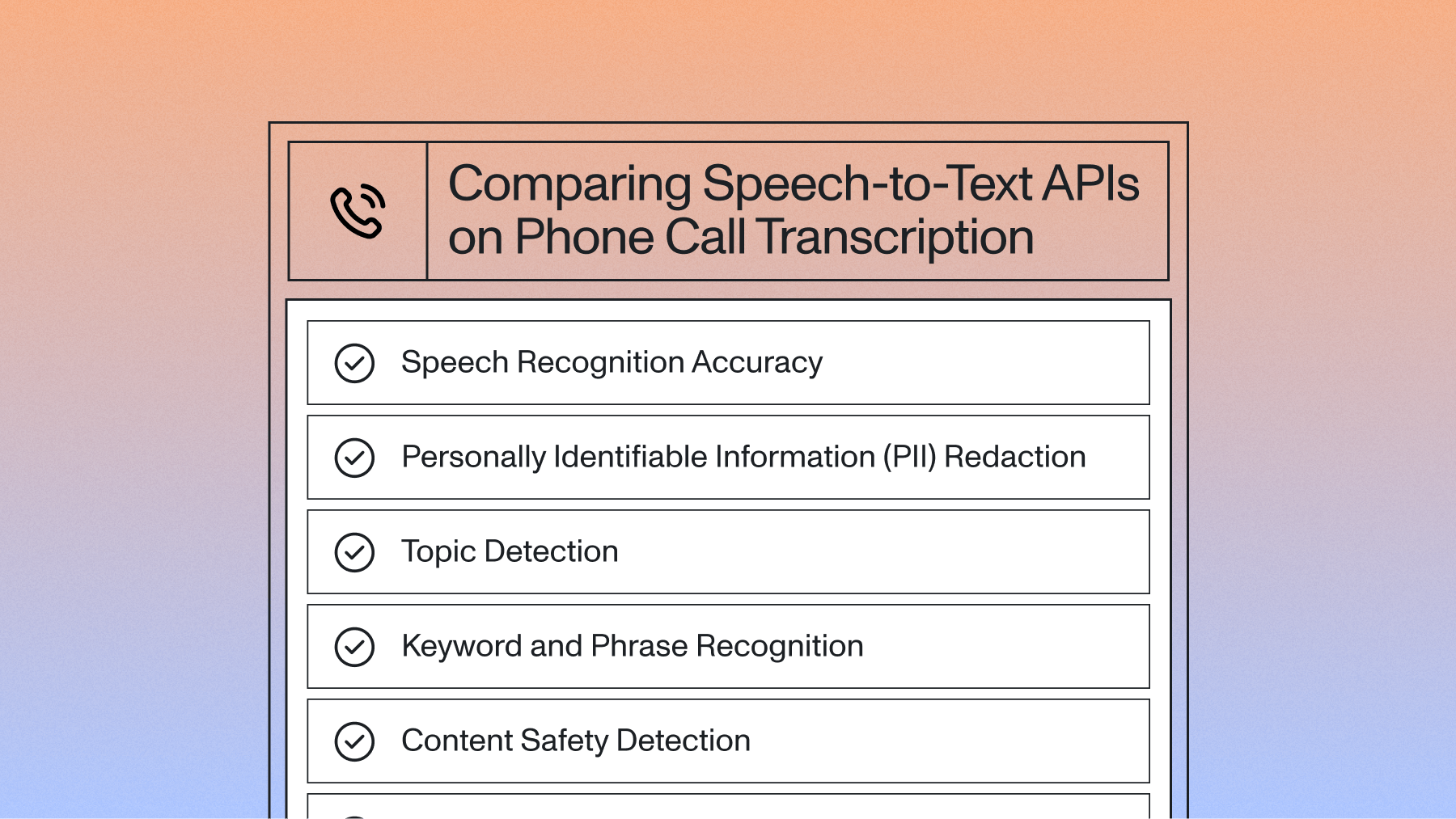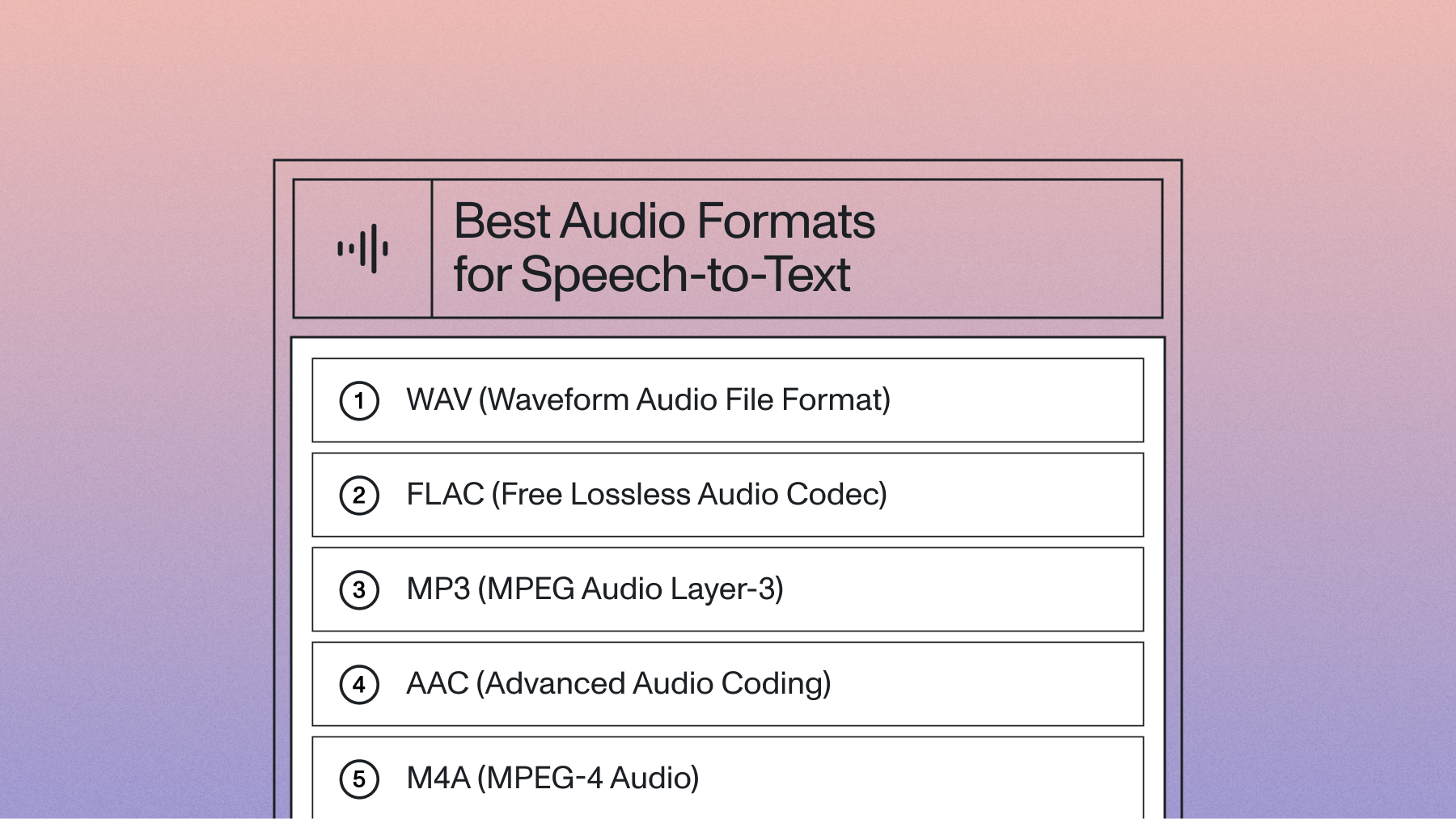How accurate is speech-to-text in 2025?
Discover speech-to-text accuracy rates in 2025, measurement methods, real-world benchmarks, and optimization strategies for developers building voice-enabled applications.



Speech-to-text accuracy determines whether AI applications succeed or fail in production. Whether you're building meeting transcription, contact center analytics, or voice assistants, accuracy directly impacts user experience and business outcomes. This guide covers current accuracy benchmarks, measurement methods, factors affecting performance, and optimization strategies for developers implementing speech recognition in 2025.
Modern speech recognition systems achieve over 90% accuracy in optimal conditions, with leading models performing even better. But the real story is more nuanced—accuracy varies dramatically based on audio quality, accents, domain-specific terminology, and real-world conditions that benchmarks don't always capture.
What is speech-to-text accuracy?
Speech-to-text accuracy measures how well an AI model converts spoken words into written text compared to a human-generated transcript. It's typically expressed as a percentage, where 100% means perfect transcription with no errors.
But here's where it gets interesting—accuracy isn't just about getting words right. Modern speech recognition systems must handle punctuation, capitalization, speaker changes, background noise, and context-dependent phrases. A system might correctly transcribe "there," "their," and "they're" phonetically but still fail if it chooses the wrong spelling for the context.
The difference between 85% and 95% accuracy might seem small, but in practice, it's enormous. An 85% accurate system produces about 15 errors per 100 words, making transcripts difficult to read and requiring significant manual cleanup. A 95% accurate system produces only 5 errors per 100 words—often just minor punctuation or formatting issues that don't impede understanding.
How is speech-to-text accuracy measured?
Word Error Rate (WER)
The industry standard for measuring speech recognition accuracy is Word Error Rate (WER). This metric calculates the percentage of words that are incorrectly transcribed, substituted, inserted, or deleted.
Here's how WER calculation works:
WER Formula: (Substitutions + Insertions + Deletions) / Total Words in Reference × 100
Example calculation:
- Reference transcript: "The quick brown fox jumps over the lazy dog" (9 words)
- AI transcript: "The quick brown fox jumped over a lazy dog" (9 words)
- Errors: 1 substitution ("jumps" → "jumped"), 1 substitution ("the" → "a")
- WER: (2 errors ÷ 9 total words) × 100 = 22.2%
- Accuracy: 100% - 22.2% = 77.8%
Beyond WER: Real-world accuracy metrics
WER provides a standardized comparison, but it doesn't tell the complete story. Other important metrics include:
Character Error Rate (CER): Measures accuracy at the character level rather than word level, useful for languages without clear word boundaries.
Semantic accuracy: Evaluates whether the meaning is preserved, even if specific words differ. "Cannot" vs "can't" might register as a WER error but convey identical meaning.
Domain-specific accuracy: How well the system handles specialized terminology in fields like medical, legal, or technical domains.
Current speech-to-text accuracy benchmarks
Industry-standard datasets
Most accuracy claims reference performance on standardized datasets:
LibriSpeech: Clean, read speech from audiobooks. Models typically achieve 95%+ accuracy on this dataset, but it doesn't reflect real-world conditions.
Common Voice: More diverse speakers and accents, representing realistic usage patterns. Accuracy rates are generally 5-10 percentage points lower than LibriSpeech.
Switchboard: Conversational telephone speech, which is significantly more challenging due to crosstalk, hesitations, and informal language.
Real-world vs. benchmark accuracy
There's often a gap between benchmark performance and real-world accuracy:
Factors that impact speech-to-text accuracy
Understanding what affects accuracy helps you optimize your implementation and set realistic expectations.
Audio quality factors
Microphone quality: Higher-quality microphones capture clearer audio signals, directly improving transcription accuracy. Built-in laptop microphones typically produce lower accuracy than dedicated USB microphones or headsets.
Background noise: Even moderate background noise can significantly impact accuracy. Traffic, air conditioning, or office chatter can cause transcription errors, particularly for quieter speakers.
Audio compression: Compressed audio formats (like heavily compressed MP3 files) or low-bitrate streaming can introduce artifacts that confuse speech recognition models.
Recording environment: Rooms with hard surfaces create echo and reverberation, while soft furnishings absorb sound and reduce clarity.
Speaker-related factors
Accent and dialect: Models trained primarily on one accent or dialect may struggle with others. However, modern systems increasingly handle diverse accents better than earlier generations.
Speaking pace: Very fast or very slow speech can reduce accuracy. Most systems perform best with natural, conversational speaking speeds.
Pronunciation clarity: Mumbling, slurred speech, or speaking while eating/drinking significantly impacts accuracy.
Voice characteristics: Some voices—whether due to pitch, tone, or speech patterns—are inherently easier for AI systems to process accurately.
Content and context factors
Vocabulary complexity: Simple conversational language typically achieves higher accuracy than technical jargon or specialized terminology.
Proper nouns: Names of people, companies, or places often cause errors, especially if they're not in the model's training vocabulary.
Numbers and dates: "Fifteen" vs "50" or "May 3rd" vs "May 3, 2023" can be challenging to disambiguate without context.
Language mixing: Code-switching between languages within a single conversation reduces accuracy for most models.
Industry applications and accuracy requirements
Different use cases have varying accuracy requirements based on their tolerance for errors and the cost of mistakes.
Contact centers and customer service
Accuracy requirement: 90%+ for automated systems, 85%+ for agent assistance
Contact centers processing thousands of calls daily need high accuracy for sentiment analysis, compliance monitoring, and automated responses. Even small improvements in accuracy can significantly impact customer satisfaction and operational efficiency.
Meeting transcription and note-taking
Accuracy requirement: 88%+ for readable transcripts, 92%+ for searchable archives
Meeting transcription tools must balance accuracy with real-time performance. Users typically accept minor errors in live transcripts but expect higher accuracy in final processed versions.
Voice assistants and commands
Accuracy requirement: 95%+ for critical commands, 90%+ for general queries
Voice assistants need extremely high accuracy for important actions like making purchases or sending messages, but can tolerate lower accuracy for informational queries where users can easily request clarification.
Legal and medical transcription
Accuracy requirement: 98%+ due to regulatory and safety requirements
High-stakes domains require near-perfect accuracy because errors can have serious legal or medical consequences. These applications often combine AI transcription with human review and editing.
Improving speech-to-text accuracy in your applications
Pre-processing optimization
Audio enhancement: Clean up audio before transcription by reducing background noise, normalizing volume levels, and filtering out artifacts.
Format optimization: Use uncompressed or lightly compressed audio formats when possible. WAV files typically produce better results than heavily compressed MP3s.
Segmentation: Break long audio files into smaller segments to improve processing and accuracy, particularly for batch transcription tasks.
Implementation best practices
Custom vocabulary: Many speech-to-text services allow you to specify custom vocabularies for domain-specific terms, proper nouns, or company names that appear frequently in your content.
Language model adaptation: Some providers offer ways to adapt their language models to your specific use case, improving accuracy for your particular domain or speaking style.
Confidence scoring: Use confidence scores to identify potentially inaccurate transcriptions and flag them for human review or additional processing.
Multi-pass processing: Run important audio through multiple models or processing passes, then combine results to improve overall accuracy.
Quality assurance strategies
Human-in-the-loop validation: For critical applications, implement human review processes for low-confidence transcriptions or high-importance content.
Error pattern analysis: Track common error types in your specific use case and adjust preprocessing or post-processing to address them.
Continuous monitoring: Monitor accuracy metrics over time to identify degradation or opportunities for improvement.
The future of speech-to-text accuracy
Speech recognition accuracy continues to improve through several technological advances:
Larger training datasets: Models trained on more diverse, extensive datasets handle edge cases and accents better than previous generations.
Multimodal approaches: Combining audio with visual cues (like lip reading) or contextual information improves accuracy in challenging conditions.
Real-time adaptation: Models that adapt to individual speakers or specific contexts during use, learning and improving throughout a conversation.
Edge processing: Running speech recognition locally on devices reduces latency and can improve accuracy for personalized use cases.
Measuring and monitoring accuracy in production
Once you've implemented speech-to-text in your application, ongoing measurement ensures consistent performance:
Establish baselines: Test your implementation with representative audio samples to establish accuracy baselines for your specific use case.
Track confidence distributions: Monitor the distribution of confidence scores over time—shifting patterns may indicate audio quality changes or model drift.
User feedback integration: Collect user corrections and feedback to understand where your system struggles most in real-world usage.
A/B testing: Compare different models, settings, or preprocessing approaches using controlled tests with identical audio samples.
Final words
Speech-to-text accuracy in 2025 enables practical applications across industries. Success depends on understanding your specific use case, audio conditions, and user requirements. Focus on factors you control—audio quality, implementation practices, and ongoing optimization—to achieve accuracy levels that deliver real value. Even small improvements dramatically impact user experience and business outcomes.
Test Universal-2's accuracy or explore Slam-1's domain-specific capabilities with your own audio samples. Get started with $50 in free credits to test accuracy with your own audio samples.
Lorem ipsum dolor sit amet, consectetur adipiscing elit, sed do eiusmod tempor incididunt ut labore et dolore magna aliqua. Ut enim ad minim veniam, quis nostrud exercitation ullamco laboris nisi ut aliquip ex ea commodo consequat. Duis aute irure dolor in reprehenderit in voluptate velit esse cillum dolore eu fugiat nulla pariatur.

.png)




